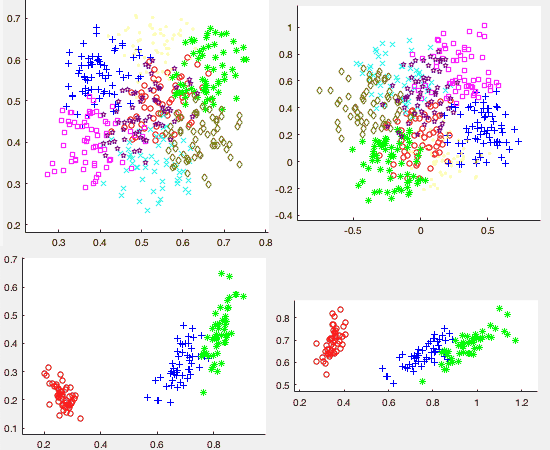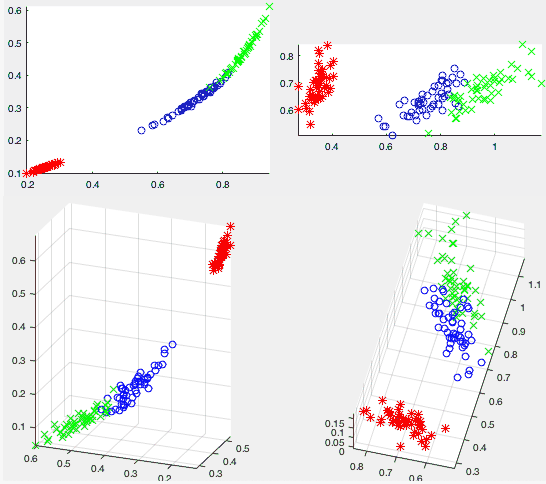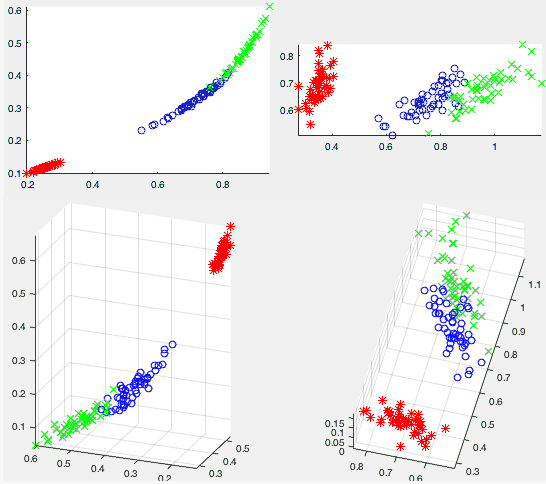Next: Competitive Learning Networks Up: ch10 Previous: Back Propagation
Autoencoder is a neural network method that learns to represent
the patterns in a given dataset in such a way that both the
dimensionality and the noise are reduced. An autoencoder is
similar to the back propogation network in that it is composed
of an input layer that takes the input pattern 







An autoencoder is similar to the PCA algorithm in that both can extract essential information from the data and thereby compress the data without losing information. However, the PCA does this in a linear manner as its output principal components are linear combinations of the input signal components, but the components generated by the hidden layer nodes of an autoencoder are nonlinear functions (due to the activation function) of the input signal components. This nonlinearity makes an autoencoder more powerful.
The computation taking place in an autoencoder can be
considered as an encoding/decoding process. The encoder
is composed of an encoder composed of the input layer
and the hidden layers, and a decoder is composed of the
hidden layers and the output layer. Same as in back
propogation, a pattern vector 
 |
(66) |
 |
(67) |
 and
and  are updated during training
in the back propogation process so that the following
objective function for the squared error between the input
and desired output, the same as the input, is minimized:
are updated during training
in the back propogation process so that the following
objective function for the squared error between the input
and desired output, the same as the input, is minimized:
 |
(68) |
By limiting the number 

![${\bf x}=[x_1,\cdots,x_d]^T$](img44.svg)

It is interesting to compare the autoencoder and the KLT
transform in terms of how they map a given data vector

![[*]](crossref.png) ):
):
![$\displaystyle {\bf y}=\left[ \begin{array}{c} y_1\\ \vdots \\ y_d
\end{array} \...
...n{array}{c}
{\bf v}_1^T{\bf x}\\ \vdots\\ {\bf v}_d^T{\bf x}
\end{array}\right]$](img345.svg) |
(69) |
 of
of
 is the inner product of the ith eigenvector
is the inner product of the ith eigenvector
 and the input
and the input  (the projection of
(the projection of
 onto
onto  if it is normalized). On the
other hand, in a neural network, the activation of the
ith node
if it is normalized). On the
other hand, in a neural network, the activation of the
ith node
 is a function of the
inner product of the weight vector
is a function of the
inner product of the weight vector  of the
node and the input
of the
node and the input  . In the special case when
the activation function
. In the special case when
the activation function  is linear (an identical
function), the eigenvectors
is linear (an identical
function), the eigenvectors  and the weight
vectors
and the weight
vectors  play the same role as the basis
vectors that span the space, and the two methods are
essentially the same. But as in general,
play the same role as the basis
vectors that span the space, and the two methods are
essentially the same. But as in general,  is a
nonlinear function, the autoencoder is a nonlinear
mapping, of which the KLT, as a linear mapping (a rotation
in the space) is a special case.
is a
nonlinear function, the autoencoder is a nonlinear
mapping, of which the KLT, as a linear mapping (a rotation
in the space) is a special case.
Dimension reduction exemplified by the KLT is effective if the components of the pattern vectors are highly correlated, i.e., some of them may carry similar information and therefore are redundant. However, if this is not the case, i.e., if all components carry their own independent information, dimensionality reduction will inevitably cause significant information loss.
Example 1:
Both dimension reduction methods of autoencoder and KLT
are applied to two sets of data, the 4-D iris dataset of
three classes and a 3-D containing eight classes each in
one of the octants of the space, for comparison of the
class separability measured by

![[*]](crossref.png) ) in
here, and the
classification accuracy (by the naive Bayes method)
measured by error rate, the percentage of misclassified
samples. Specifically, during the back propagation
training of the autoencoder, all samples in each dataset
are used in random order as both the input and the desired
out for the network gradually learn these patterns.
) in
here, and the
classification accuracy (by the naive Bayes method)
measured by error rate, the percentage of misclassified
samples. Specifically, during the back propagation
training of the autoencoder, all samples in each dataset
are used in random order as both the input and the desired
out for the network gradually learn these patterns.

The figures above show the two datasets (the 3-D 8-class dataset at top, the 4-D 3-class iris dataset at bottom) when mapped to a 2-D space by the two methods (autoencoder on left, KLT on right). We note that the distribution of the data points are similar in the 2-D spaces resulted from the two methods, indicating these spaces are spanned by similar basis vectors, i.e., the weight vectors of the two hidden layer nodes are similar to the eigenvectors used in the KLT. However, by visual observation, the class separability in the 2-D space produced by the autoencoder (left) seems to be better than that by the KLT (right), which is also conformed quatitatively.
We Note that in the first dataset, all three
dimensions are equally important for the representation
of the 8 classes, i.e., the dimensionality can hardly be
reduced without losing significant amount of information.
In fact, the three dimensions after the KLT contain
roughly the same percentage of energy:

We see that for both datasets, the performance of the autoencoder method (to the left of the slash symbol) is always better than that of the KLT method (to the right of slash) with higher separability and lower error rate.
 |
(70) |
Example 2: In general, the autoencoder network is trained by all samples in the dataset. However, if all samples in a dataset are labeled to belong to one of a set of classes, the autoencoder can also be trained by these classes. Specifically in this example, the three classes in the iris dataset each represented by the average of all samples in the class are used to train the autoencoder. The figure below shows the 4-D iris dataset mapped to 2-D (top) and 3-D (bottom) spaces by both the autoencoder (left) and KLT (right). It is interesting to observe that in the case of autoencoder (left), the data points representing the three classes are arranged into a line structure in both 2 and 3-D spaces.

To encourage sparsity of the hidden layer, most of the hidden layer nodes to be inactive, we include an extra penalty term in the objective function to discourange hidden layer nodes from being activated.
There are two typical ways to do so:
 |
(71) |
We first define the sparsity parameter 

 |
(72) |
 represents how much the jth hidden layer
node is affected by the kth input
represents how much the jth hidden layer
node is affected by the kth input  . The difference
between the desired sparsity in terms of
. The difference
between the desired sparsity in terms of  and the
actual activation
and the
actual activation  can be measured by the
KL-divergence
can be measured by the
KL-divergence
 |
(73) |
 is treated as the desired probability of
is treated as the desired probability of  for a binary random variable (Bernoulli distribution, with
probability
for a binary random variable (Bernoulli distribution, with
probability  for
for  ), and
), and
 treated
as the actual probability of the binary random variable.
This KL-divergence is minimized when
treated
as the actual probability of the binary random variable.
This KL-divergence is minimized when
 .
The penalty term is the sum of the KL-divergences of all
.
The penalty term is the sum of the KL-divergences of all
 hidden layer nodes:
hidden layer nodes:
 |
(74) |
 |
(75) |
Autoencoder and PCA are similar for XOR and cocentric datasets. but different for data of digits from 0 to 9
